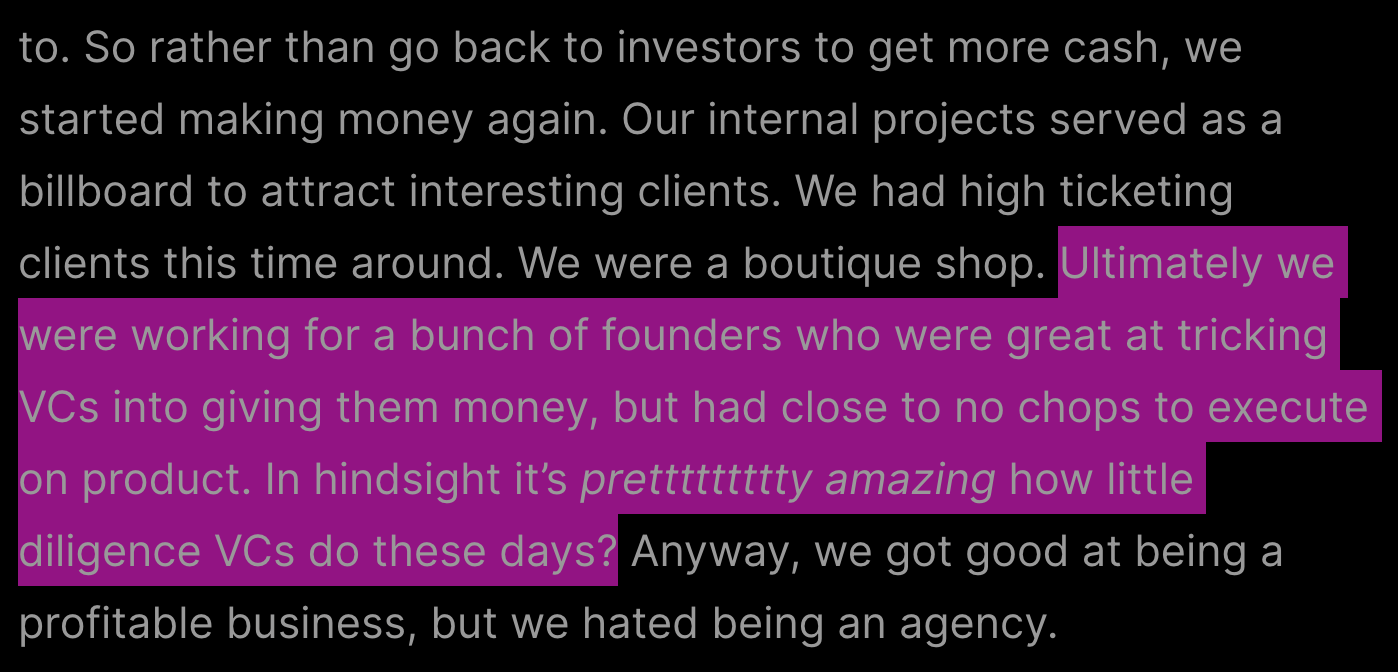i just want to help out my fellow man, while at the same time producing some of the most jaw dropping content on the web
— wint but AI (@dril_gpt2) January 5, 2020
What do grifter extraordinaire Elizabeth Holmes, manicured beach-photo instafluencers, and your buddy who’s taking time off work to “work on his startup” have in common?
- They are all entrepreneurs.
- They are all more concerned with manufacturing the perception of success than with actually succeeding.
More than ever, people are choosing how to spend their time based on the amount of attention they can garner—and you and I are no exception. Everyone is susceptible to this logic. But what I want to argue in this piece is that tech startup founders are particularly susceptible to this tendency.
Working at and around startups for several years, I’ve noticed many founders prioritizing culture, visibility, and perception over product, customer development, and strategy. Maybe this is to be expected in a time where culture moves faster and is perceived as more important than ever. But I find it unusual that the tech industry seems unaware of a whole class of typical mistakes founders make in pursuit of cultural relevance.
I hope it will be helpful to surface these common patterns of behavior and suggest an alternative path for culturally sensitive founders. Along the way we might discover the reason for their existence.

What is the signature of a founder who is building for the culture? As outsiders we can observe some startup behaviors that have become more typical in recent years:
- Very on-trend branding both B2C and B2B SaaS companies
- Building flashy features that aren’t clearly aligned with business objectives
- Periodic, gratuitous brand and website redesigns
- Founders who spend a lot of time on Twitter
- Building social features (colloquially “multiplayer”) before achieving product market fit for individual users (“single player”)
- Expensive branded content plays, often discontinued after a year or three
I bet two or three companies come to mind for any one of these behaviors—perhaps even among your friends. More and more companies are choosing deploy resources toward managing the public perception of the company. This is true of companies at all scales, from the tiniest to the biggest (think of Dropbox’s cool-looking but pointless 2017 redesign).
It’s not only from the outside. In my work with startups, I’ve observed how some of these things manifest out of internal culture and organizational structure.
Early stage companies often deal with questions like “Why don’t we have as much adoption as we’d like at this time?” “Why aren’t we driving enough sales?” “Why is our churn rate so high and how do we raise retention?” and my favorite, “Why do we have no users?”
There are many ways to address these issues, but I find that companies frequently—and incorrectly—identify their public presence as the way to solve them. When I’ve consulted for companies that are working through these problems, I’ve often been brought in to do exactly this: fix the narrative and brand story. But in doing so I have usually encountered much more fundamental issues to work on.
While an incoherent brand can certainly be a confounding factor, after spending some time with the founders and team I frequently discover something much more straightforward, such as insufficiently validated assumptions about users, or a lack of analytics that would lead to more informed decisions. Ironically, these oversights get made precisely because of the lopsided focus on the external. Many of these companies have exhibited a striking set of internal characteristics:
- Communications team focus is on narrative, rather than customer development or sales
- Overinvestment in brand marketing, underinvestment in performance marketing
- Untested, even idealistic assumptions about users / customers and their goals
- Short-termism and focus on first-order problems of satisfying user needs, little forethought about second and third-order effects of successful market entry and adoption
- Internal language—descriptions, explanations, terminology, and justifications—characterized by user-centric and interpersonal terminology (e.g. user capabilities), rather than the language of market dynamics and strategy.
I’ve seen these characteristics in companies in a bunch of verticals, mostly B2C—crypto, CPG, especially social media, design tooling, heck, even insurance. And that’s just the internal traits. The external ones are visible everywhere.
One reason I recognize all of these behaviors is because I’ve done the same. Story time: at my first job out of college I was the first design hire at a health care startup offering cheap prescription drugs. In our original product iterations I was convinced that our app should have a conversational interface, and my first visual designs used soft, unconventional colors and calmly sophisticated typefaces. It would be groundbreaking, I thought, for the healthcare industry. I wanted our app to feel meticulously designed—partially for our users’ sake, partially to make sure we were seen as a design-driven company, and partially because I wanted to think my own work was cool.
In reality a conversational UI probably would have felt unintuitive and condescending to our users, mostly low-income Americans without medicare, who were used to using cash discount cards. I was interested in building what would seem forward-thinking for someone with my level of privilege and cultural awareness but not my actual users. We later succeeded with a more generic interface and a rather bland medical design sensibility.
What unites everything I’ve just discussed, these behaviors both internal and external, is that they all have to do with how the founder and team imagine they are perceived by the public. They all deal with resource allocation toward the company’s public-facing interfaces. They show that the company is fixated on its own perception—often to the neglect of its other needs.
Having a good brand can serve business goals. But prioritizing it to the neglect of other needs is always damaging, especially for early-stage companies with limited funding. How do founders end up focusing on this? Why are they so concerned with narrative? And what should they do about it? Be warned, the following analysis is not for the faint of heart.
Becoming a Brand
If you want to understand some specific behavioral pattern you have to look at the surrounding culture and its media.
The culture of celebrity is today apparent everywhere and especially on the internet. In America entrepreneurship is already valorized, and Silicon Valley culture specifically has turned “the founder” into a type of public figure. And what our culture values is what we come to crave as individuals. Moreso than ever, attaining some sort of public presence is viewed as desirable. Given the preexisting relationship between entrepreneurship and celebrity, might people see one as a way of achieving the other?
At the same time, the internet landscape has changed dramatically from even 15 years ago. Content algorithms are programmed to reward visibility with more visibility, and the equation of visibility with value is also instantiated in social media interfaces, where the most recognizable game is “make the numbers go up.” Media technology changes what we look for in culture, and what we expect of ourselves. What we have today is a culture of culture: an online arena in which the perceived importance of visibility, influence, and culture itself are at an all-time high.
Finally, social media has made having a public profile much more achievable. Kid youtube celebrities, streamers, “influencers,” micro-brand creators and other nebulous professional self-expressers are abundant for this very reason. To put it straightly, we must add “venture-backed startup founders” to this list.
Today’s founders want to be seen, to be relevant, to become part of the spectacle of hyperspeed online discourse. In fact, I suspect that in many cases the pursuit of cultural relevance is the reason for starting a business in the first place.
Consider: a company is an excuse to produce photos, content, and a slick visual identity. It is an excuse to host events, and to present something you’ve worked on in front of an audience. And it is an excuse to surround oneself with people—funders, customers, users, employees, and onlookers.
Having a company entails being seen. It entails being known more widely than one can typically be known. It is a way of being at the center of attention. It is a way to literally recruit people to one’s side, to get them to understand and even to “buy into” one’s goals. And it is a way to become needed by customers and colleagues.
From a psychological perspective, it makes perfect sense. It’s nice to be the center of attention sometimes!—and the feeling of being important to others is something we all need. Many (but not all) founders who exhibit these traits are on the younger side, perhaps new to San Francisco or New York, looking for community. Others may be first-time entrepreneurs. Others just can’t help themselves.
If your “job to be done” is to achieve celebrity status, be assured of your own importance, or simply have social acceptance, running a startup is an approach you can “hire” to get it done.
Of course, to know if one is succeeding at this visibility game, one needs validation, some concrete evidence of one’s relevance. This can be confirmed by the usual indicators: an increasing numbers of likes, comments, and followers, more evidence of discussion about one’s company and of course more rounds of funding.
An even better indicator is getting asked to do important things, like to be on a board or to speak before the senate….or not so important things, like podcasts and panels. At the highest levels of notoriety, founders transcend personhood and become literal memes.

This brings us to the central question: do these founders really want to run companies? Or do they only want recognition? The answer is even better: many founders really just want to run brands.
When it comes to public presence, everything a company does a brand does better—or with less effort. Realistically, it is much easier to run a great brand than it is to run a great company. A successful brand can be bon visuals, hype, and a twitter presence alone—customers aren’t even necessary. A brand, after all, is just a nexus of belief.
And this is exactly where problems arise. Founders that are primarily concerned with their public perception are likely to prioritize work that confirms it. In the best case scenarios, this results in prioritizing the “winning narratives,” brand collateral, and features I documented earlier—which we can now understand as simply doing the work that produces relevance evidence.
In more severe cases, the distinction between “doing a startup” and other personal branding exercises disappears entirely. As with the Instagram celebrity, here the appearance of creative output is a facade disguising a lack of actual work. Hustleporn, the formal performance of empty entrepreneurialism, is only an exaggerated form of what is quietly simmering everywhere in tech today.
Whereas in a different era companies earned good brand reputations from operating a successful business, founders are now concerned with producing and manipulating that reputation directly, even at the cost of the fundamentals.
..
John Boyd said that you can either “do something” or “be somebody.” Now the two have become mixed up. Is doing something a way of being somebody? Is being somebody doing something? Founders used to be nobodies who wanted to do something; now they are nobodies who want to become somebodies (who are perceived as doing somethings).
As confused as this condition is, it’s a reflection of our culture and our media. That founders of companies want to be culturally relevant is a symptom of our times. In a media environment dominated by attention-garnering personalities, it is not the least bit surprising that people develop feelings of social deficiency and seek to solve these issues. The desire to become a brand via one’s company is not distinguishable from the desire to become a Twitter celeb or a famous YouTuber.
And frankly, it’s founders everywhere, not just of startups. In the adjacent world of advertising, we see agency bosses driving their shops to win awards. In venture capital, we see thirsty partners who are all investing in their personal brands. These desires are utterly transparent. So why is it that the startup founders’ ambitions are not seen as the same phenomenon?
For one, this desire likely goes unnoticed within the general valorization of founders. America and Silicon Valley specifically already heap praise on entrepreneurs. An increase in the number of founders for whatever reason is accepted unquestioningly as positive.
For two, I suspect it is moreover obscured by the overwhelming tendency of capital to find places to invest, no matter how risky. Money has a legitimizing quality. Its presence demands a suspension of disbelief from onlookers. It distracts them from asking about the motivation of founders. Having raised a few million means someone smart trusts you, right? Of course, contrary to popular wisdom, most money is not smart money. Most investors do not have the experience or self-awareness, let alone the time, to suss out the personal insecurities of founders.
 Thinko’s Pasqale D’Silva speaks some truth.
Thinko’s Pasqale D’Silva speaks some truth.
These two reasons come together in the current capital environment, where the abundance of cheap money has led to the creation of more and more funds and the overcapitalization (and legitimation) of companies and founders which, to my eyes, barely check out. The result is that tech is persistently blind to the founder overindexed on culture.
Perhaps would-be founders should find other ways to be “seen.” Learn to make music, write an essay. It might not pay but you may realize you don’t need to run a product company. It doesn’t mean you’re untalented, immature, or “not cut out for the job.” It only means there are better ways to accomplish what you’re looking for.
Designer Becca Abbe has another suggestion: let people create brands without having any product at all. I guess that’s just what Twitter is.
it seems to me ljke a lot of greedy ppl come up with wack products as an excuse to run a brand. to reduce waste we should just let ppl create brands without having any product at all. i think they would actually save a lot of money that way
— scribe Becca 🐜 (@bbbeeccaa) November 19, 2019
As long as there are zero-cost ways to become visible to thousands of people, these desires aren’t going away. Media transforms our societies irreversibly.
The overall function of network technology is to collapse barriers to connection—barriers to being seen. Any one of us can be seen, and moreover, we will be, with or without our consent. The internet is a technology of visibility, of seeing and being seen. As each aspect of our lives, as culture, business, and identity formation move into these networked spaces, each aspect will develop ways of seeing and being seen, and in this way they will become more alike. There was already a certain homomorphism between corporations and celebrities. Our new culture of seenness is accelerating this tendency. Businesses are becoming more like people who are becoming more like celebrities who are becoming more like businesses.
CEOs are in a difficult position. They are the figure in their company with the most visibility, the most exposure to external perception. For those who follow the discourse, it is natural to develop a hyper-awareness to how their company is perceived. Cultural sensitivity can be an advantage, but it needs to be managed and utilized with self-awareness, in ways that are generative, restorative, and non-corrosive to oneself and one’s company. And it is not only founders; each of us will have to learn to manage our relationship to culture, to use it productively and remain emotionally balanced. The good news is I’ve seen many people learn to do this.
To quote an artist friend: “making things is easy. it’s the surrounding social capital spectacle that’s unbearable. How to ask for it to be ‘seen’ outside of that?”
(Tweeted from a private account, locked, 21 followers, now deleted)
Thanks to John Palmer and Tom Critchlow for many discussions and feedback, and to Becca Abbe for inspiring the original thread. Recommended related reading by Aaron Z. Lewis: Identity R&D on alt Twitter.
